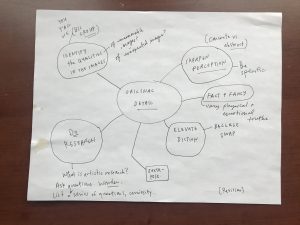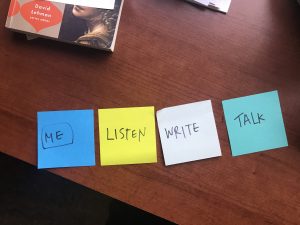Here’s my approach to planning one session of a flipped/blended seminar course.
First, I find it useful to narrow down the scope of the class to one big idea for the week. To do this, I use concept mapping as my process. Then, I begin to match learning activities to particular essential questions this big idea raises.
As the class begins to take shape, I use post-it notes to colour code the variations in the kinds of activities I’ve chosen: active, independent, small group vs. large, discussion, writing prompt, movement, sitting still, etc., so I have a visualization of the rhythm of the session.
CONTENT
Process: Concept Maps
- Determine the big idea or main concept for the week, e.g. “dialogue” “scene vs. summary” “diction” “original detail”
- Begin to generate questions around this concept
- Gather materials and resources around those questions (often, this is pre-work the student has engaged in before class)
- Begin to consider the learning activities that give students the opportunity to engage with the concept

FORM
Process: Post-it notes
- Determining what learning activities are best for your subject/concept/genre depends on timing and comfort level
- Learners focus for 15 – 20 minute intervals, so aim to move between active and passive / independent and group activities, and vary your approaches
- Colour-code activities and map it out so you can see the learning experience (as in the second photo below, my colour-coded lecture for CRWR 201)


LEARNING ACTIVITIES
PROCESS: Experimentation!
Resources
Choosing Appropriate Strategies for Learning
Long But GOOD Resource Regarding Group Work
Bookmark CULT OF PEDAGOGY!
TEMPLATES
I would be very happy to provide resources, discuss suitable learning activities, and speak generally about facilitation anytime!
Have fun,
Sheryda
